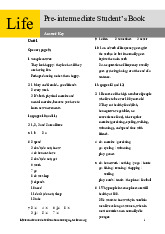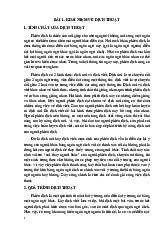





Preview text:
LESSON PLAN
TIẾNG ANH 11 FRIENDS GLOBAL
UNIT 3: SUSTAINABLE HEALTH
LESSON 3A- VOCABULARY: PARTS OF THE BODY I. OBJECTIVES
By the end of this lesson, students will be able to: 1. Knowledge
- Identify parts of the body.
- Gain vocabulary to talk about injuries and treatments.
- Review present perfect and past simple.
- Gain some trivial knowledge about the body. 2. Competences
- Discuss various parts of the body.
- Understand a conversation between doctors and their patients.
- Talk about experiences related to accidents and injuries.
- Develop self-study skills, collaborative skills and creativity. 3. Personal qualities
- Build an awareness of taking good care of different parts of the body.
- Be collaborative and supportive in pair work and teamwork.
- Actively join in class activities. II. MATERIALS
- Grade 11 textbook, Unit 3, Vocabulary
- Computer connected to the Internet - Projector / TV - PowerPoint Unit 3A III. PROCEDURES
1. Activity 1: WARM-UP: (5 mins) a. Objectives:
- Introduce the new lesson and set the scene for Ss to acquire new language.
- Get students' attention at the beginning of the class.
- Activate students’ background knowledge. b. Content:
- The Scary monster activity: students work with their friends to recreate c. Products:
- Drawings and responses to the drawings from students d. Procedure
TEACHER’S AND STUDENTS’ ACTIVITIES CONTENT THE SCARY MONSTER - T puts Ss into teams.
- Each team sends 1 member (the artist) to the front
of the class with a sheet of paper and a pencil
- Those artists have to face their back to the
board/screen and look at their friends.
- The rest have to describe the monster for the artists
for them to draw in 2 minutes.
- The team that has drawn the most identical monster
to the original wins the game.
- T times Ss and monitors them throughout the activity. e. Assessment
- Teacher observes the groups and give feedback.
2. ACTIVITY 2: PRESENTATION (10 mins) a. Objectives:
- Students learn the form, pronunciation and when to use vocabulary related to the topic. b. Content:
- Pre-teach vocabulary related to the topic. - Exercise 1. - Exercise 2. c. Products:
- Ss discuss with their friends, do exercises in the book and say aloud the new vocabulary items d. Organisation
TEACHER’S AND STUDENTS’ ACTIVITIES CONTENTS
Exercise 1: Describe the photo. How is the footballer feeling? What has happened, do you think? (2 mins)
- T focuses Ss’ attention on the photo.
- In pairs, Ss discuss what might have happened to the woman.
- T asks a few students to share their ideas with the class. (Possible answer)
The footballer is lying on the football pitch.
She is in pain and has probably hurt her ankle in a tackle.
Exercise 2: Match 1–14 in the photo with parts of the body from the list below. Check the
meaning of all the words in the list (8 mins)
- T asks Ss to match fourteen of the words with the nail /neɪl/
parts of the body in the photo. wrist /rɪst/
- T checks answers as a class. calf /kæf/
- Ss look at the slides and say aloud the words and elbow /ˈɛlboʊ/ look shoulder /ˈʃoʊldər/ neck /nɛk/ cheek /tʃik/ forehead /ˈfɔrˌhɛd/ ankle /ˈæŋkəl/ shin /ʃɪn/ knee /niː/ thigh /θaɪ/ chin /tʃɪn/ thumb /θʌm/ e. Assessment
- Teacher observes Ss’ writing of vocabulary on their notebooks.
- Teacher checks students’ pronunciation and gives feedback.
3. ACTIVITY 3: PRACTICE (20 mins) a. Objectives:
- Identify parts of the body by answer some questions.
- Review present perfect and past simple.
- Gain some trivial knowledge about the body.
- Understand a conversation between doctors and their patients. b. Content: - Exercise 3. - Exercise 4. - Exercise 5. - Exercise 6. c. Products:
- Ss discuss with their friends, do exercises in the book and conduct oral correction. d. Organisation
TEACHER’S AND STUDENTS’ ACTIVITIES CONTENTS
Exercise 3: Work in pairs. Which parts of the body in the list in exercise 2 (5 mins)
- T puts Ss in pairs and gives them 2 minutes to 1 are inside your body?
work with their friends to ask and answer the
2 are part of your head or neck? questions.
3 are part of your arm or hand?
- Ss volunteer to answer the questions.
4 are part of your leg or foot?
- T checks and shows visual aids for clarification Answer key:
1 blood, brain, heart, intestine, kidney, lung,
muscle, rib, skull, spine, stomach, throat
2 blood, brain, cheek, chin, eyebrow, eyelid,
forehead, jaw, lip, muscle, scalp, skin, skull, spine, throat
3 blood, elbow, muscle, nail, skin, thumb, wrist
4 ankle, blood, calf, heel, knee, muscle, nail, shin, skin, thigh, toe
Exercise 4: Work in pairs or small groups. Do the body quiz on page 37. Check your
answers with your teacher + Game show: Who wants to be the millionaire? (5 mins)
- T goes through the quiz questions and check that students understand them.
- In pairs or groups, students do the quiz and write
the answers in their notebooks. Do not check answers at this point.
- T conducts a game show to check the Ss’ answers
- Who wants to be a millionaire? – Ss can volunteer Answer key:
to answer the questions or Ss work in groups and 1 c 2 c 3 c 4 b 5 a 6 c 7 b
take turns to give the answers.
Exercise 5. Listen to three dialogues between doctors and their patients. Complete the table using
the words below to complete the treatments. (7 mins)
- T goes through the instructions of the listening Answer key:
- Pre-teach vocab for listening: T lets Ss do a
quick matching exercise to teach them new vocab
items and conducts oral drill for pronunciation
- T plays the recording for students to complete the table.
- Ss check the answer with their friends and listen
the recording the second time.
- T checks answers as a class.
Exercise 6. Read the Recycle! box. Complete the extracts from the dialogues with the verbs in
brackets. Use the present perfect or past simple. Listen again and check your answers. (5 mins)
- Ss read the Recycle! Box to review past simple Answer key:
and present perfect. They then read the dialogues from the recording. - Ss complete the dialogue.
- T plays the recording again for students to check their answers.
- T uses slides to teach some vocab from the
listening about accidents and injuries. New words:
- T goes through the slides again after teaching to bang /bæŋ/ (v.)
conduct oral drill, individual drill for pronunciation nosebleed /ˈnəʊzbliːd/ (n.) check. bruise /bruːz/ (v.) (n.) burn /bɜːn/ (v.) (n.) twist /twɪst/ (v.) e. Assessment
- Teacher observation on Ss’ performance.
- Teacher’s feedback and peers’ feedback.
4. ACTIVITY 4: PRODUCTION (10 mins) a. Objectives:
- Talk about experiences related to accidents and injuries. b. Content: - Exercise 7 c. Products:
- Students give a short talk. d. Organisation
TEACHER’S AND STUDENTS’ ACTIVITIES CONTENTS
Exercise 7. Work in pairs. Ask and answer about experiences using the present perfect and the
phrases below. If the answer is ‘yes’, give more information (10 mins)
- Ss to look at the example questions and answers, and
to start their questions with Have you ever …?
- In pairs, students ask and answer the questions in 5 mins.
- T lets Ss play “Have you ever…?: Invite a student to
stand up and pick a box. There is a question starting
with “Have you ever..?” in that box. Ss raise their hands
if their answers to the question is “Yes”. Then T can
invite one of the Ss to talk about their experiences. e. Assessment
- Teacher observation on Ss’ performance.
- Teacher’s feedback and peers’ feedback. 5. CONSOLIDATION (2 mins) a. Wrap-up
- If T is using the Classroom Presentation Tool, first do the lesson closer to review what has been covered in this lesson.
- T asks students: What have you learned today? What can you do now? and elicits answers: I
can identify parts of the body. I can talk about injuries using the present perfect and past simple. b. Homework
- Prepare for the next lesson




